Policy Gradient variants, like PPO, GRPO, all optimize for this objective:
The correctness of each 𝗶𝗻𝗱𝗶𝘃𝗶𝗱𝘂𝗮𝗹 sample 𝘺.
👉 This optimizes for exactly the pass@1 metrics in training time. Training with a pass@1 objective won't probably yield pass@k miracles.✨
It's a different RL paradigm, in which the reward is not only a function of single trajectory, but a population of trajectories.
Given k samples, pass@k is 1 if at least one of them is correct.
✨ We can define the reward exactly as the maximum of the individual reward.
We observe a 𝗰𝗹𝗲𝗮𝗿 𝘁𝗿𝗮𝗱𝗲-𝗼𝗳𝗳 between pass@1 and pass@k if you train them using different objective:
If you train for pass@1, you get pass@1 increase on eval.
If you train for pass@k, you get pass@k increase on eval.
It's just that simple.
Apr 27, 2025 · 4:30 PM UTC
For more details have a look at our preprint in March.
arxiv.org/abs/2503.19595
Joint work with @robinphysics @syhw and 𝗥𝗲𝗺𝗶 𝗠𝘂𝗻𝗼𝘀






